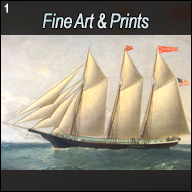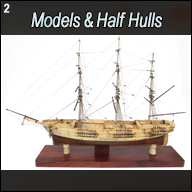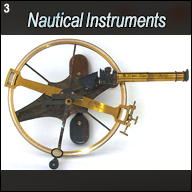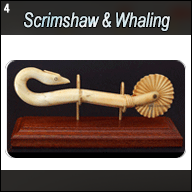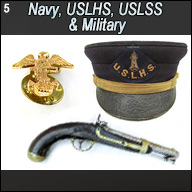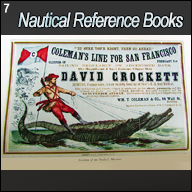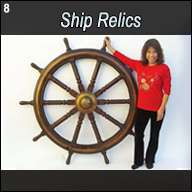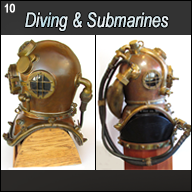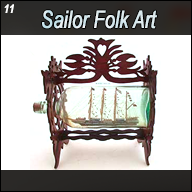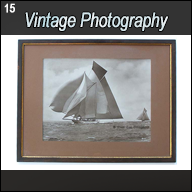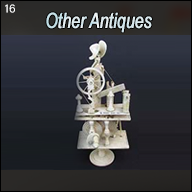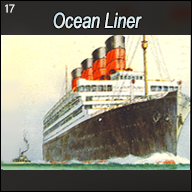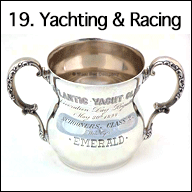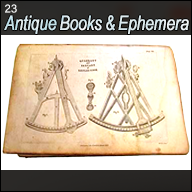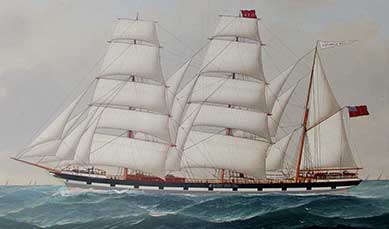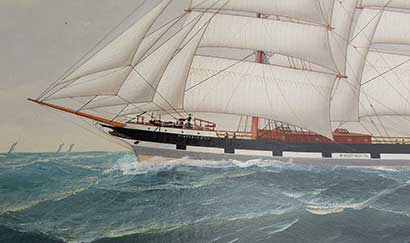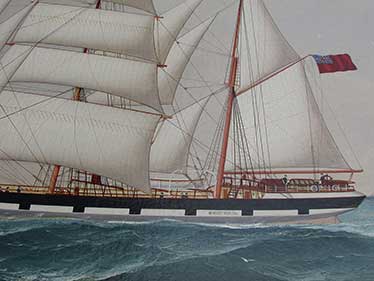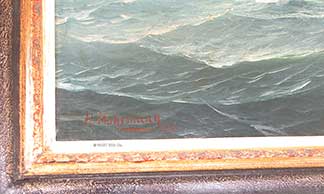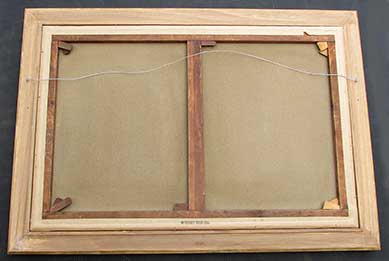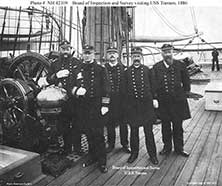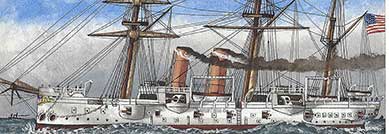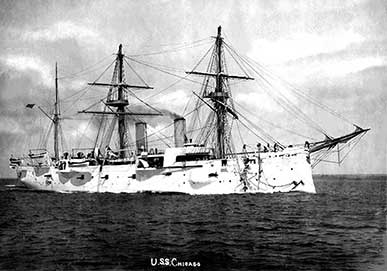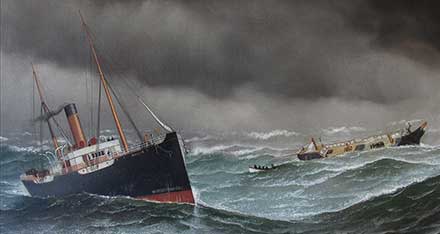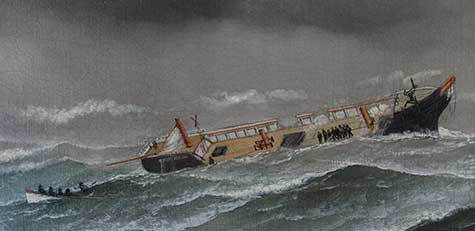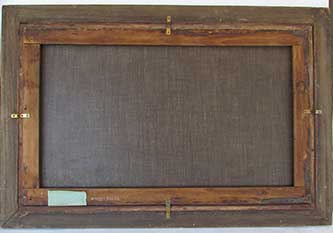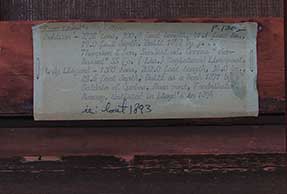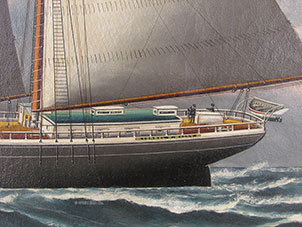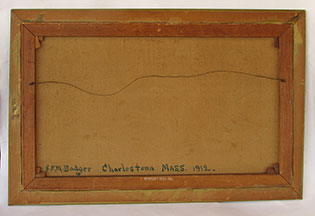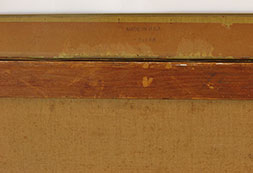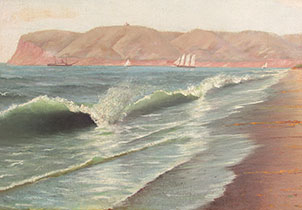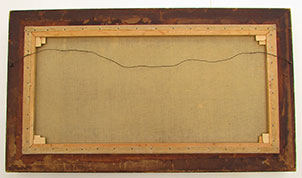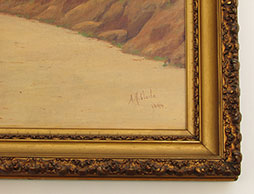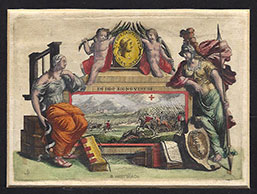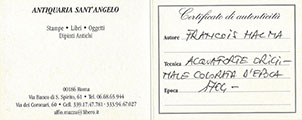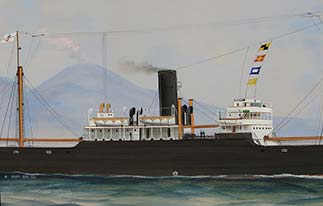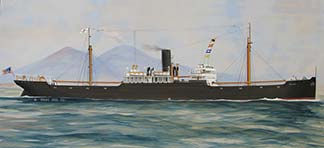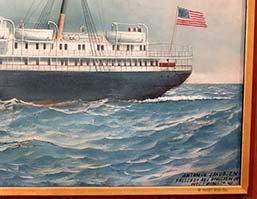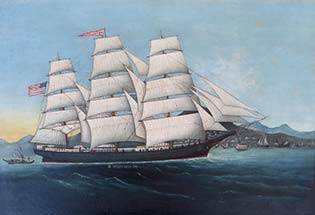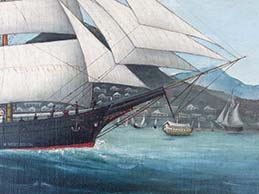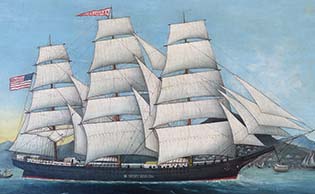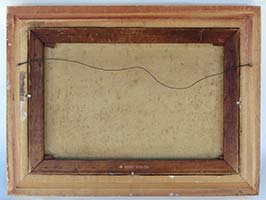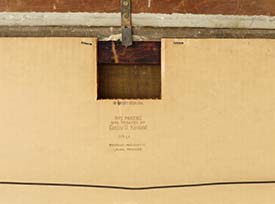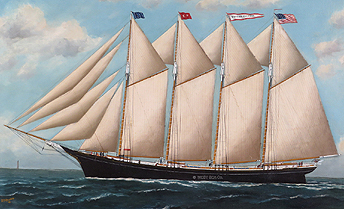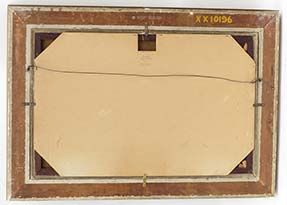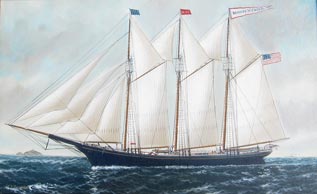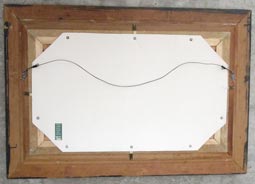1. Fine Art & Prints
Prices in U.S. Dollars are in GREEN
 |
1.99 FAMOUS EARLY ENGRAVING. Guaranteed authentic, period copper plate engraving depicting the namesake of America, entitled “Amerigo Vespucci” in an elaborate setting befitting his discovery of “America.” This original depiction shows the famous explorer surrounded by iconic elements rich with the promise of fascinating new discoveries. At the top is a celestial globe describing the constellations. It is flanked by floral wreaths and festooned garlands. The image of the explorer himself is very bold. He holds a mariner’s chart divider and an early compass with a galleon in the background. Another terrestrial globe is to his left. Two dragon-like dolphins adorn the bottom of the image which is boldly entitled “AMERICUS VESPTUTIUS” at the bottom. Beautifully framed under old wavy glass in an antique orate gilt gesso frame 9 ½ by 14 1/2 inches sight. The frame measures 12 ¼ by 17 ¼ inches. Outstanding original condition for this historic relic over 350 years old! Ready to hang. One of the oldest antiques we have ever offered. 595 The famous explorer Amerigo Vespucci (1451-1512) was a Florentine (Italy) navigator whose name “America” was given to the newly discovered continent. Between 1497 and 1504, he sailed on two voyages in the “Age of Discovery;” the first on behalf of Spain (1499–1500) and then Portugal (1501–1502). In 1501, while on his Portuguese expedition Vespucci determined that Brazil was part of a fourth continent heretofore unknown to Europeans. He called it the “New World.” His claim inspired cartographer Martin Waldseemuller to recognize Vespucci's accomplishments. In 1507 he applied the Latinized name "America" to a map showing the New World. Other cartographers followed suit. By 1532 the name America was permanently affixed to the newly discovered continent(s). In 1671 cartographer and bookseller, John Ogilby, published “America, being an accurate description of the New World.” Ogilby’s book was an English translation of a work describing North and South America by Dutch writer Montanus. Ogilby’s “America” was lavishly illustrated with plates and maps by Jacob van Meurs, the Amsterdam engraver who published the original Dutch version. Subsequently he allowed Ogilby to borrow his copper plates. Although it claimed to be “An accurate description of the New World,” the work contained many errors which included fanciful descriptions of the people and animals of the Americas. Since neither Montanus nor Ogilby had actually visited the New World they were reliant on explorers’ accounts and secondhand descriptions. Even so, the book was widely read by Europeans fascinated by the New World. Despite its shortcomings, it continued to be a valuable source of information about the flora and fauna of America at that time. It also provided an illustrated account of the arrival of the Native Americans (assuming they immigrated from somewhere else) and the exploration and conquest of the New World by the Europeans, beginning with Christopher Columbus. |
 |
 |
| detail | back |
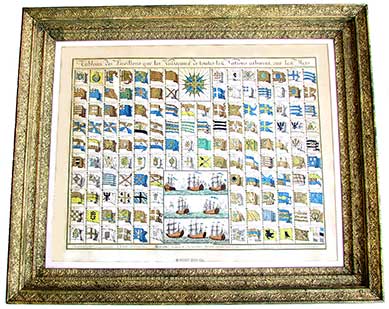 |
1.98 WORLD CLASS MARITIME BROADSIDE. Ultimately rare! Proudly offered here is an amazing early depiction of maritime flags from around the world at the very beginning of the 18th century! Unbelievably, this museum piece is still in private hands rather than on public display. Of French origin, it is entitled “Tableau Des Pavillons que les Vaisseaux Ve toutes les Nations arboureni sur les Mers.” Signed and dated “par Matthieu Seutter 1712.” It contains no less than 112 engraved images of country flags flown by seafaring nations of the era. The black and white printing process of the time was beautifully enhanced by meticulous hand coloring. Many of the governmental flags represented have long disappeared over the centuries. But some are still recognizable. They include: “Royal Anglettere (Britain), Jerufalem, Royal France, Provence, Anglais Jack, Calais, Dunkerque, Finland,Hollande, Malte, Pavillion du Pape, Portugal, Venise, Tunis, Florence, Monaco, Algier, and Chine Empereur” among others. The top of the display is inset with an elaborate compass rose depicting the 32 Cardinal, Intercardinal and sub-points of the compass. Each is identified. A second inset at the bottom center depicts 7 port quarter views and one starboard quarter view of period Naval ships with elaborate decorated sterns, identified by number. Four are shown engaged in battle. These are (top, left to right), “1. Pour parler au Commendant, 2. Pour appeler les Captaines avec leurs principaux pilots., 3. Pour appeler les Capitaines a bord., 4. Pour la decouverte de quelque danger., 5. Pour apparceiller de jour., 6. Pour la décourverte de Vaisseaux. 7. Pour fairepasser les Vaisseaux derrière le Commendant., 8. Pour la decouverte d une terre oừ l’on veut aborder.” This magnificent presentation was professionally conserved with acid-free mounting under real glass in a genuine antique gilt gesso frame befitting its importance. The outer dimension of the frame is 30 by 36 inches. The frame opening measures 29 ½ inches by 23 ½ inches. The actual image measures 28 ½ inches by 22 ½ inches sight. Overall condition and preservation is simply remarkable after more than 300+ years! This medium is a stone lithograph on laid, rag paper with watermarks. The images are clear and crisp. Made long before chromolithography, the hand-coloring is rich, meticulous and without flaw. The coloring alone must have taken skilled artisans untold hours of dedicated work. Truly amazing! Without a doubt this rare piece belongs in a museum. But -- for now at least -- it is still available for YOUR private museum!Price Request This presentation represents the oldest piece of artwork we have ever offered in the 41 years we have been in business. 312 years old! |
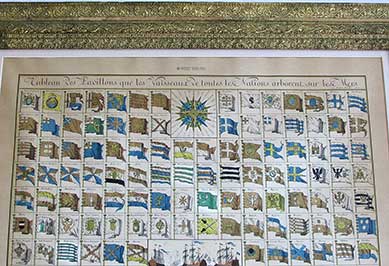 |
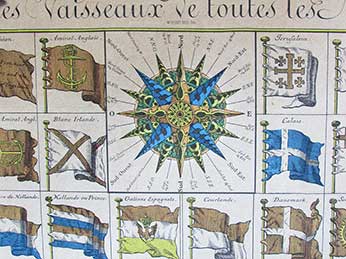 |
| detail | compass rose |
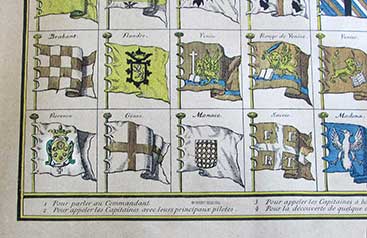 |
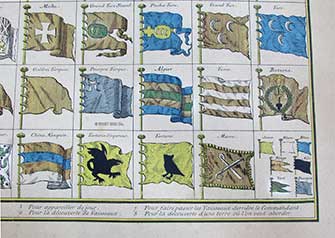 |
| lower left | lower right |
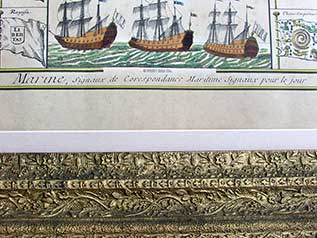 |
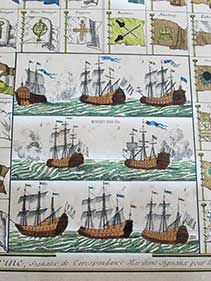 |
| center detail | ships detail |
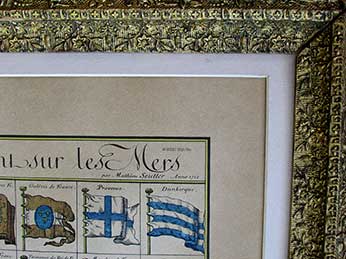 |
| maker & date |
 |
1.97 PAINTING, AMERICA’s MOST FAMOUS SHIP. Water color on silk, H. Shimidzu, Japanese, early 1900’s. Exquisite rendering of one of the most enduring and fabled ships in the United State Navy, the venerable USS CONSITITION, depicted here underway in choppy seas under full sail. The majestic ship is shown flying the commissioning pennant from the main and old glory at the stern. Significantly, many crewmen are shown precariously astride the bowsprit reefing the jib sails while many more are portrayed on the foc’sle. It is boldly signed “US. FRIGATE “CONSTITUTION BY. H. SHIMIDZU. YOKOHAMA JAPAN. 1930. “ The painting measures 14 ¼ by 20 ¼ inches. It is in brilliant, MINT condition, having never been displayed or seen the light of day. For over 90 years it has been kept in its original tube with the silk pinned to its rice paper backing. A very rare depiction of the famed American ship known as “OLD IRONSIDES” by this noted Japanese port painter. 1195 From the estate of a pre-War American merchant marine sailor. Ship portrait artists, in the tradition of earlier European port painters, began appearing in Japan in the early 1900’s. The first and perhaps best known marine painter of that era was H. Shimidzu, who painted from his studio in Yokohama, Japan. He created a number of small to medium size oil and watercolor paintings on silk and became a very popular ship portraitist. His works show a high degree of skill and accuracy which usually depicted steamers or sailing ships. He sometimes included a local background, often Mount Fuji. Shimidzu is represented in the Peabody Museum, Salem, Massachusetts as mentioned in their Catalogue and in other literature about Marine Artists (e.g., Archibald, “Dictionary of Sea Painters” and Dorothy Brewington, “Dictionary of Marine Artists”). |
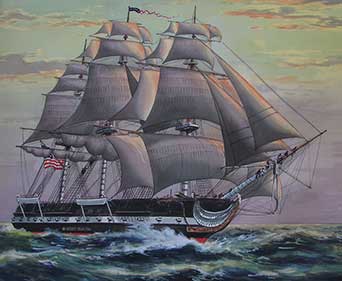 |
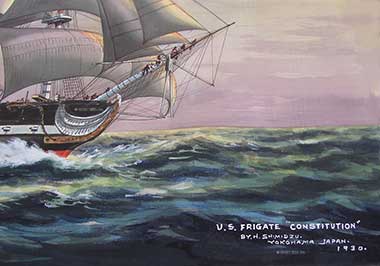 |
| ship | signature |
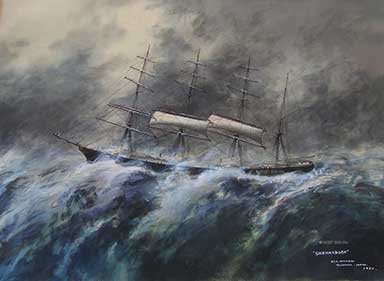 |
1.96 WATERCOLOR ON SILK. H. Shimidzu, Japanese, early 1900’s. Amazingly detailed painting of the famous Confederate Clippership SHENANDOAH in a gale. The painting is signed lower right “SHENANDOAH By. H. SHIMIDZU, Yokohama Japan. 1930.” It portrays this most famous rebel ship plowing through massive storm tossed seas under reefed sail on the main and mizzen. Details of the ship are exquisite, with the artist conveying dramatic movement and magnitude of the moment. The painting measures 14 by 19 inches. It is in brilliant, MINT condition, having never been displayed or seen the light of day. For over 90 years it has been kept in its original tube with the silk pinned to its rice paper backing. A rare depiction of a classic Civil War clippership by this most famous Japanese ship portrait painter. Ready for framing. 995 Interestingly, Shimidzu has taken artistic license in portraying SHENANADOAH as a 4-masted bark, when in reality she had 3 masts! From the estate of a pre-War American merchant marine sailor. Ship portrait artists, in the tradition of earlier European port painters, began appearing in Japan in the early 1900’s. The first and perhaps best known marine painter of that era was H. Shimidzu, who painted from his studio in Yokohama, Japan. He created a number of small to medium size oil and watercolor paintings on silk and became a very popular ship portraitist. His works show a high degree of skill and accuracy which usually depicted steamers or sailing ships. He sometimes included a local background, often Mount Fuji, or in this rare case, the Tokyo skyline. Shimidzu is represented in the Peabody Museum, Salem, Massachusetts as mentioned in their Catalogue and in other literature about Marine Artists (e.g., Archibald, “Dictionary of Sea Painters” and Dorothy Brewington, “Dictionary of Marine Artists”). Name: SEA KING, SHENANDOAH, EL MAJIDI Renamed : CSS SHENANDOAH CSS SHENANDOAH, formerly known as SEA KING then EL MAJIDI, was an iron hulled full-rigged sailing ship with teak decking famous for her actions under LCDR James Waddell of the Confederate States Navy during the American Civil War. SHENANDOAH was originally a British merchant ship launched as SEA KING on August 17, 1863, but was repurposed to become one of the most feared commerce raiders in the Confederate Navy. For more than 12 months from 1864 to 1865, the ship undertook commerce raiding around the world in an effort to disrupt the Union's economy. Its efforts resulted in the capture and the sinking of 38 merchant vessels, most of which were whaling ships. She finally surrendered on the River Mersey, Liverpool on November 6, 1865, fully six months after the war had ended! SHENANDOAH was known to have fired the last shot of the Civil War when she encountered a whaler in waters off the Aleutian Islands. Initially intended for the Far East tea trade and troop transport for the growing intervention of Western powers in China, she began to be fitted out as U.S. representatives assessed her for purchase. After a number of trips carrying cargo to the Far East and transporting troops to the New Zealand Wars, the Confederate Navy secretly purchased her from Wallace Bros. of Liverpool in October 1864. Renamed CSS SHENANDOAH, the ship was converted into an armed cruiser with a mission to capture and destroy Union merchant ships. Liverpool was the unofficial home port of the Confederate overseas fleet and the city provided ships, crews, munitions, and provisions of war. SEA KING sailed from London on October 8, 1864, ostensibly for Bombay, on a trading voyage. At the same time the Steamer LUAREL sailed from Liverpool. The two ships rendezvoused at Funchal, Madeira. LUAREL carried officers and men, along with naval guns, ammunition, and ship's stores. The new Confederate cruiser was commissioned on October 19, 1864, lowering the Union Jack and raising the Confederate flag under the name CSS SHANANDOAH. At the outset, the Confederacy tasked SHANANDOAH to strike at the Union's economy by "seeking out and destroying" its global commerce. Captain Waddell began attacking enemy merchant ships on the Indian Ocean between the South Africa and Australia, and in the Pacific. En route to the Cape of Good Hope, the Confederates captured 6 prizes. After the crews and passengers had been removed 5 were burned or scuttled. The sixth was bonded and used to transport the prisoners to Bahia, Brazil, where they were released. |
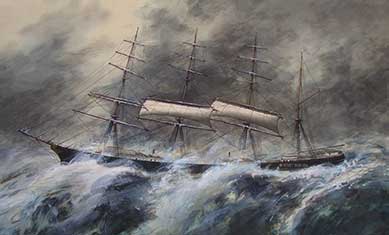 |
 |
| ship | signature |
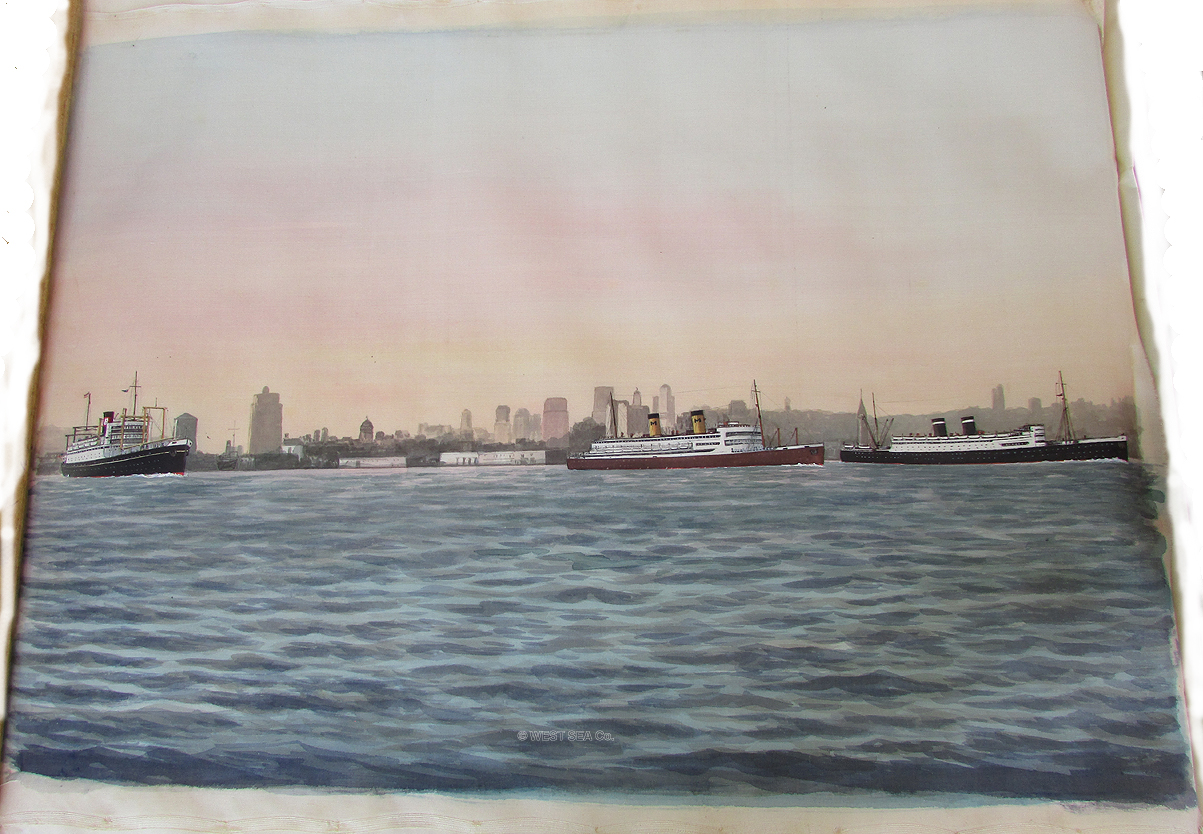 |
1.95 WATERCOLOR ON SILK. H. Shimidzu, Japanese, attributed. Amazingly detailed painting of a rare pre-war waterfront scene depicting American shipping in Tokyo Harbor circa 1930. This panorama is undoubtedly by the hand of the very talented Japanese port painter H. Shimidzu who worked in Japan in the 1920’s and 30’s. What is most unusual about this particular work is it’s not a typical Shimidzu ship’s portrait, but rather a panorama portraying several famous American steamships underway in the harbor. On the left is a cargo/passenger steamer belonging to the old Dollar Line. In the center is a passenger liner of the Matson Line. On the right is a passenger liner of the States Line. All 3 ships are underway out of the harbor with their bow wakes clearly visible. The artist has meticulously captured the Tokyo waterfront with buildings, skyline and docks clearly depicted. The painting measures 14 ¼ by 20 ¼ inches. It is in brilliant, MINT condition, having never been displayed or seen the light of day. For over 90 years it has been kept in its original tube with the silk pinned to its rice paper backing. A very rare marine panorama by this most famous Japanese port painter. 1195 From the estate of a pre-War American merchant marine sailor. Ship portrait artists, in the tradition of earlier European port painters, began appearing in Japan in the early 1900’s. The first and perhaps best known marine painter of that era was H. Shimidzu, who painted from his studio in Yokohama, Japan. He created a number of small to medium size oil and watercolor paintings on silk. He became a very popular ship portraitist. His works show a high degree of skill and accuracy which usually depicted steamers or sailing ships. He sometimes included a local background, often Mount Fuji, or in this rare case, the Tokyo skyline. Shimidzu is represented in the Peabody Museum, Salem, Massachusetts as mentioned in their Catalogue and in other literature about Marine Artists (e.g., Archibald, “Dictionary of Sea Painters” and Dorothy Brewington, “Dictionary of Marine Artists”). |
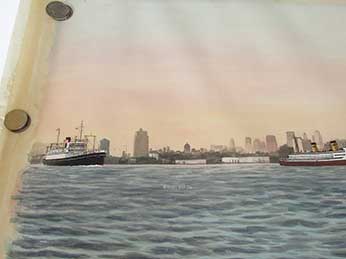 |
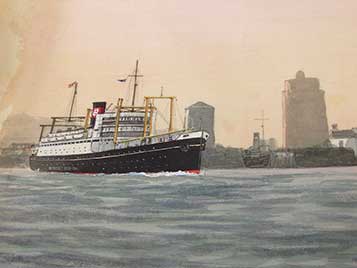 |
| docks | dollar |
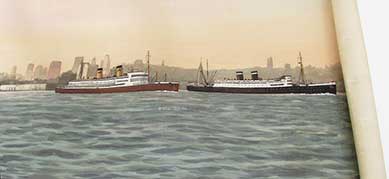 |
 |
| matson states | skyline |
 |
| tube |
 |
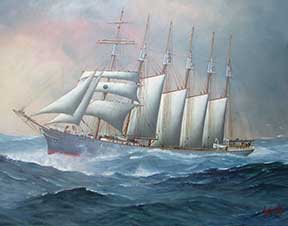 |
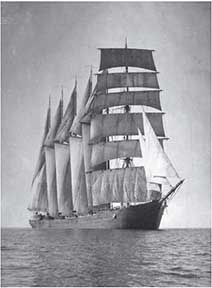 |
| ship | ship photo |
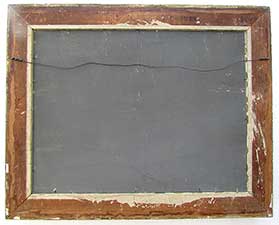 |
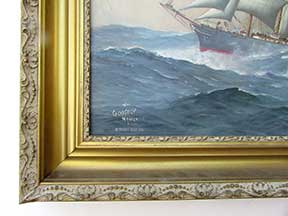 |
| back | signature 1 |
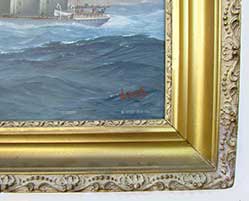 |
| signature 2 |
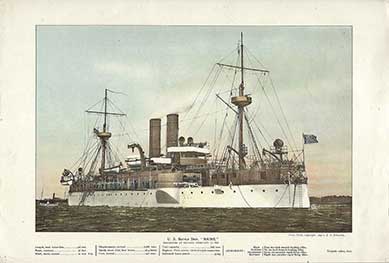 |
1.91/5.24 ORIGINAL BATTLESHIP MAINE LITHOGRAPH. Authentic, period stone chromolithograph of the immortal American Battleship U.S.S. MAINE, certainly one of the most famous battleships in American Naval history. This vivid high quality color image depicts the ill-fated ship at anchor from a starboard quarter perspective in happier times. The detail is exceptional and bears close scrutiny under magnification. It reveals many ship details including several sailors on the main deck as produced from an original copyrighted photo dated 1896. The bottom of the image contains extensive information on the ship’s characteristics and armament. This is NOT a modern dot matrix reproduction, nor is it a page from a book. It was printed in large format for singular display. With full margins it measures 8 ½ by 12 ½ inches. Outstanding original condition. Very worthy of framing. 59 The explosion and sinking of the Battleship MAINE (ACR-1) in Havana Harbor on February 15, 1898 with the loss of 260 American lives, led to America declaring war on Spain. On April 23rd, after much Yellow Journalism and political wrangling, Congress declared that a state of war had existed between the U.S. and Spain since April 21, the day the U.S. began to blockade Cuba. In the ensuing 10 weeks U.S. Naval and land forces thoroughly decimated Spanish forces. It was during this period that the vast majority of "Remember the Maine" articles of all types were offered to the American public in an effort to gain popular support for the war. This image predates the sinking. Subsequently, with resounding defeats in Cuba and the Philippines, Spain sued for peace. Hostilities were halted on August 12, 1898, when a Protocol of Peace between the United States and Spain was signed in Washington. The formal peace treaty was signed in Paris on December 10, 1898. As a result of the war the United States gained all of Spain's colonies outside of Africa, including the Philippines, Guam and Puerto Rico, excepting Cuba which became a U.S. protectorate. These gains prompted John Hay, America's Ambassador in Britain, to refer to it in a letter to his friend Theodore Roosevelt as "the splendid little war." Theodore Roosevelt and George Dewey benefited greatly from their participation in the war. Both men gained immediate fame as national heroes. Roosevelt's fame ultimately propelled him to the White House. |
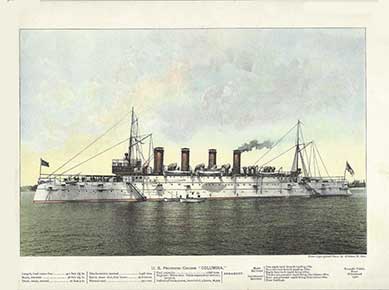 |
1.90/5.17 PERIOD NAVAL LITHOGRAPH. A fine, stone lithograph taken from an original photograph of the “U.S. Protected Cruiser COLUMBIA” as entitled at the bottom. This especially clear portside view of the late 1800’s state-of-the art fighting ship shows her at anchor with her boats alongside. She flies the Jackstaff at the fore and the American ensign at the stern. One of the 4 imposing smokestacks belches coal smoke. The colorful image it is signed “From Copyrighted Photo by William H. Ran.” Below this is detailed information about the ship’s characteristics and armament. Full margins. 12 ¼ by 8 ¼ inches. Outstanding state of original preservation after more than 120 years! 39 The USS COLUMBIA (C-12) was the 4th ship in the U.S. Navy to be named after the city in South Carolina. She was built by the William Cramp Shipyard in Philadelphia and launched on July 26, 1892 and commissioned on April 23, 1894. Her distinctive 4 smokestacks assured her place in history as a transitional steam warship from the 1800’s. But at that time, even as a steamship, she was still classified at a sailing schooner with 2 masts! COLUMBIA joined the North Atlantic Squadron in1894 and visited Europe in 1895 to represent the United States at the opening of the Kiel Canal in June. Returning home, she was placed in reserve in May of 1897. Recommissioned on March 15, 1898 for service in the Spanish–American War, COLUMBIA patrolled the Atlantic coast and West Indies until late August. She carried American troops to Puerto Rico and participated in America’s occupation in July and August. She was decommissioned and placed in reserve at Philadelphia Navy Yard in March 1899. Recommissioned in August 1902, COLUMBIA, was the receiving ship for the Atlantic Training squadron. In anticipation of World War I she was the assigned the stature of Submarine Flotilla flagship and was detached to patrol the Delaware Breakwater in April 1917. In July she joined the Cruiser Force Atlantic and escorted troops of the American Expeditionary Force to France. In July she joined the Cruiser Force as a convoy escort. In that capacity, between January and November 1918, she made five Atlantic crossings. In January 1919, she became flagship of Squadron 2 Destroyer Force Atlantic, operating on the East Coast and the Caribbean. She was relieved of that duty in May and was decommissioned at Philadelphia Navy Yard June on June 29, 1921 Reclassified as CA-16 on July17, 1920, she was renamed OLD COLUMBIA and was struck from the Naval records on June 21, 1922. |
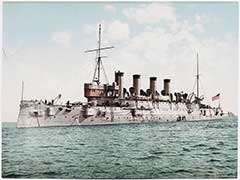 |
| photo |
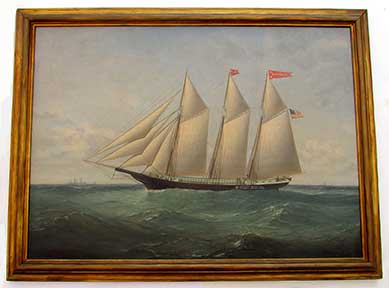 |
1.89 SHIP’s PORTRAIT. Conrad Freitag, German American (1843-1894), oil on canvas painting of the 3-masted schooner H.S. WILLIAMS underway off the port of New York with shipping on the horizon. The handsome ship is shown under full sail plying a wavy green sea. She flies the owner’s pennant form the main mast, the ship’s name pennant from the aftermast and the American ensign from the spanker. Deck detail is excellent and at least 7 crewmen are depicted including the helmsman. Below the bowsprit is the billet with ornate trailboard and the ship’s name board “H.S. WILLIAMS” clearly visible. In the distance are a larger steam/sail vessel and at least 3 other vessels under sail. Freitag’s treatment of the water is especially realistic. Few marine painters capture the essence of the open sea. It is signed and dated lower left, “C. Freitag N.Y. 1875.” This large painting measures 35 ½ by 25 /12 inches sight. It is mounted on its original stretcher in its original simple gilt wood frame measuring 40 ¼ by 30 ¼ inches. It bears the original framer’s label of “James K. Kelleher & Sons, New York City, N.Y.” It also bears an exhibition label reading “Ships. SCHOONER “H.S. WILLIAMS” by C. Freitag, N.Y. 1875 A53000” What is remarkable is the entire painting is in untouched, original condition without any restoration or inpainting whatsoever! This work of art comes directly from a single owner family. 8900 Conrad Freitag (1843-1894) was an American artist in Brooklyn, New York . He served honorably in the Civil War and discharged in 1865 to convalesce in New York. His first painting was a scene of the Battle of Spotsylvania. He soon turned to painting maritime scenes and he was best known for his portraits of New York pilot boats. His paintings were exhibited at the Brooklyn Art Association and the National Academy in the 1870’s and 80’s. His works are on now display at the Mariners Museum Newport News, Virginia; Mystic Seaport Museum, Mystic, Connecticut; the Peabody Museum, Salem, Massachusetts; and the Staten Island Historical Society, Staten Island, New York. |
 |
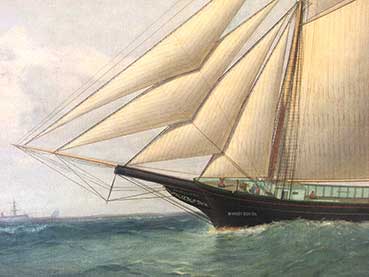 |
| SHIP | FORWARD |
 |
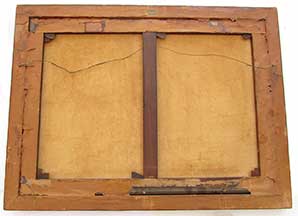 |
| STERN | BACK |
 |
 |
| EXHIBITION LABEL | FRAMERS LABEL |
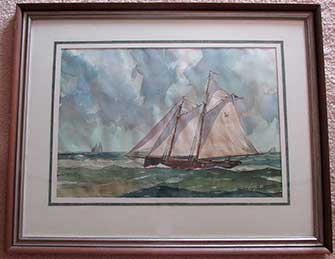 |
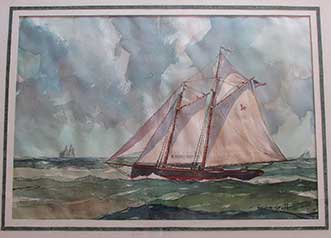 |
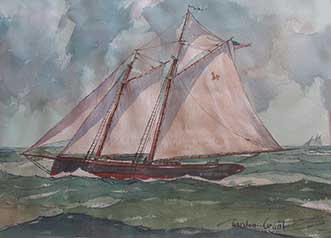 |
| image | ship |
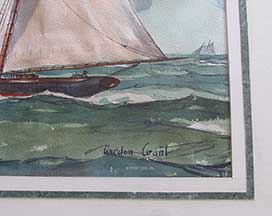 |
| signature |
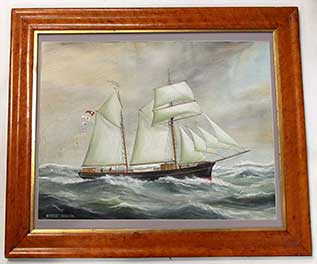 |
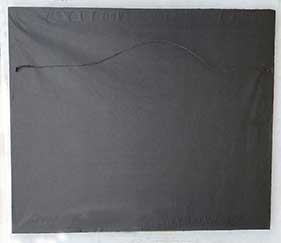 |
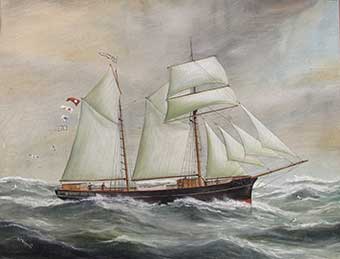 |
| back | ship |
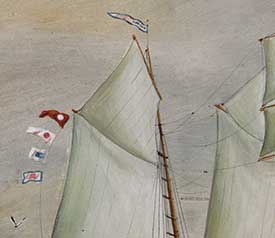 |
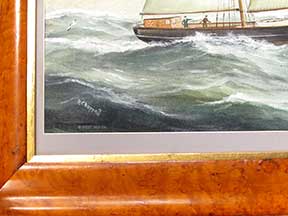 |
| flags | signature |
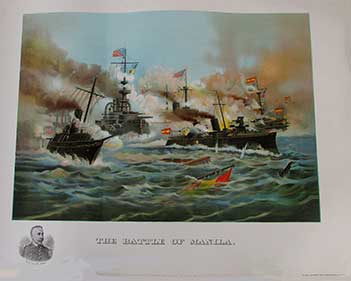 |
1.84/5.15 SPANISH-AMERICAN WAR GROUPING. Three genuine historically important items directly pertaining to the war fought between the United States and Spain in 1898. They are:
The explosion and sinking of the Battleship MAINE (ACR-1) in Havana Harbor on February 15th, with the loss of 260 American lives, led to America declaring war on Spain. On April 23rd, after much Yellow Journalism and political wrangling, Congress declared that a state of war had existed between the U.S. and Spain since April 21, the day the U.S. began to blockade Cuba. In the ensuing 10 weeks U.S. Naval and land forces thoroughly decimated the Spanish. |
 |
 |
| photo | detail |
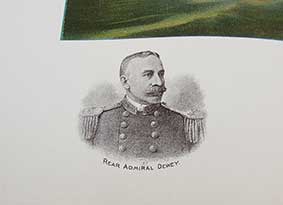 |
 |
| dewey | title |
 |
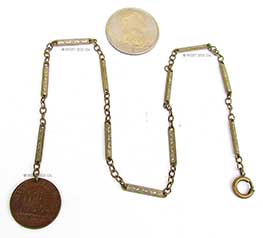 |
| printer | fob |
 |
 |
| dewey 1 | olympia |

|
1.83 SHIP's PORTRAIT. John Henry Mohrmann, oil on canvas painting of the elegant barque VICTORIA BAY heading to sea under full sail. This detailed painting is signed lower left "H. Mohrmann 1891." It depicts the lovely ship departing port with the headlands in the background on the right and numerous small sailing craft in the distance. As the ship plows through choppy seas her realistic bow wake is shown below the female figurehead and gold trailboard decoration. The ship's name is prominent on the port bow. The vessel flies the owner's flag "HCG" from the main mast and the ship's name pennant from the aftermast. The British ensign flies from the spanker aft. Mohrmann was a proficient technician who concentrated on getting all aspects of his subject 'right.' No less than 11 crewmen are shown on deck performing their duties. All aspects of the deck and its fittings are meticulously depicted. The realism of the sea with frolicking seagulls and the subtle sky are a testament to this 19th century marine artist's skill. 22 ½ inches by 34 inches sight. The ornate gilded frame with contrasty black and white elements measures 28 by 39 ½ inches. The painting has been professionally relined on its original stretcher and is in excellent condition. Ready to hang and enjoy in a most appreciative setting. Price Request |
ship |
bow detail |
stern detail |
signature |
back |

|
1.82 PAINTING EARLY AMERICAN WARSHIP. Genuine third quarter 19th century watercolor portrait of the famous steam/sail U.S. Navy ship the "UNITED STATES CORVETTE TRENTON" by listed artist James G. Maxwell 1878" as signed lower left. This detailed broadside rendering is surprisingly bright, colorful and crisp for a painting in this medium over 140 years old! It depicts the large fighting ship at anchor off a mountainous coast in calm seas with sails furled. At the peak she flies the Union Jack, while streaming the long commissioning pennant from the main and the American ensign from the spanker. This post-Civil War era gunship displays at least 9 gunports along her port side. Close inspection reveals many charming details including standing and running rigging, numerous crewmen on deck, lifeboats, gunports, accommodation ladder, davits, and her prominent single stack, among others. The scene is entitled by the artist along the bottom legend, "United States Corvette "Trenton," 13 Guns, 3400 tons, 3180 H.P. 253L, 49B, 20.D. Bt 1876." Water color and gouache on heavy rag paper. 10 by 6 1/4 inches sight. Unmounted. Perfect original condition. 775 |
1886 |
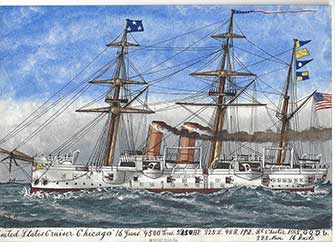
|
1.81 PAINTING EARLY AMERICAN WARSHIP. Genuine late 19th century watercolor portrait of the famous steam/sail U.S. Navy ship the "UNITED STATES CRUISER CHICAGO" by listed artist James G. Maxwell 1894" as signed lower left. This detailed broadside rendering is surprisingly bright, colorful and crisp for a painting in this medium over 125 years old! It depicts the large fighting ship underway with sails furled, flying the embarked Vice Admiral's pennant from the fore, streaming the long commissioning pennant from the main and name pennants and American ensign from the aftermast. This pre-dreadnaught battleship bristles with armament as she plies an azure sea, plowing ahead full, belching coal smoke and steam. Close inspection reveals many charming details including standing and running rigging, numerous crewmen on deck, lifeboats, gunports, davits, deck guns and Union shields fore and aft, among others. The scene is entitled on the bottom by the artist, "United States Cruiser "Chicago" 16 Guns. 4500 Tons. 5250 H.P. 325 L. 48 B. 19 D, Bt Chester 18815 G.Q.D.L. 325 Men. 16 Knots." Water color and gouache on heavy rag paper. 10 by 7 inches sight. Unmounted. Perfect original condition. 975 19th century British painter, James Scott Maxwell's work covered a narrow subject range of warships and British scenery. His paintings carried the signs of immense brilliance such as in "Villefranche 188," a drawing of a fleet of ships. Most of his paintings were small watercolors or the modest sketches of steamers, like "Clyde," "Duchess of York," and "Ben Lomond," all carried out in small, 7 by 9 inch frames or slightly larger. The first USS CHICAGO was a protected cruiser of the United States Navy, the largest of three ships authorized by Congress for America's "New Navy" and one of the first steel ships in the U.S. Navy. Launched on December 5, 1885 by Delaware River Iron Ship Building and Engine Works of Chester, Pennsylvania, commissioned April 17, 1889. She had a displacement of 4,500 tons with an overall length of 342 feet 2 inches. Her beam was 48 feet 3 inches and she had a draft of 19 feet. With fourteen (!) 100 psi boilers running two compound overhead beam steam engines she produced 5,084 shaft horsepower turning twin screws to achieve a speed 16 mph. She was bark-rigged in accordance with the plan of the "New Navy" to extend the range of newly built ships of the era, making her one of the very few in the history of the U.S. Navy to be powered by steam and sail during the very narrow window of history from the Civil War leading up to the Spanish-American War, a mere 33 years later! |
detail |
ship |

|
1.29 MINIATURE PORTRAIT ON IVORY. Absolutely exquisite 18th century portrait miniature painting of a very lovely young woman dressed in her finery in a very suggestive portrait for its time. This detailed rendering features a beautifully detailed oval portrait executed in the most detailed manner. The subtle features of her face, hair and drapery are of the highest order adding to the realism of this form of lifelike portrayal of the elite, who could afford it, prior to the advent of photography in the 1830's. The image is signed lower right "Server," possibly French. It is housed under convex beveled glass in its ornate gilded oval frame measuring 2 ½ by 3 1/8 inches. The top back is equipped with a small pivoting suspension ring for hanging. A tremendous bargain! Was $895 NOW! 295 |
signature |
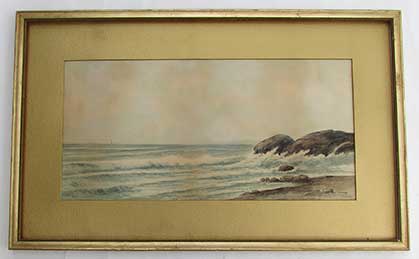
|
detail |
back |
signature |
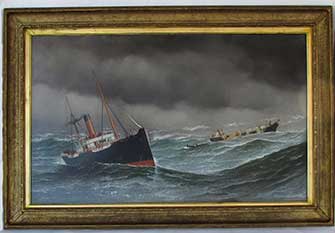
|
detail |
the rescue |
back |
label |
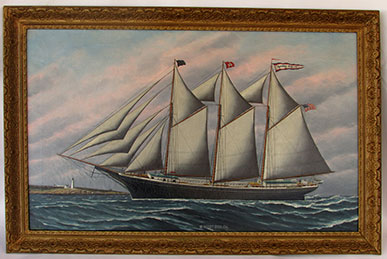
|
1.77 SHIP’s PORTRAIT. Solon Francis Montecello Badger, American (1873-1919), oil on canvas, the 3-masted schooner Isabel B. Wiley sailing past Portland Head light, Cape Elizabeth, Maine. Signed and dated lower left “S.F.M. BADGER 12,” and inverso boldly signed “S.F.M. Badger Charleston Mass. 1912.” This classic broadside ship’s portrait depicts the lovely vessel on her port beam under full sail heading south backed by rocky headlands and a lighthouse in the distance. Five crewmen are depicted on deck, including the helmsman and the Captain on the poop pointing the way. The ship is clearly identified in three places: on the port bow, the port quarter, and on the huge name pennant flown from the spanker mast. She flies the house flag of Drake & Son (a “D” within a white star) from the mainmast, and the Union Jack from the foremast. The American ensign flies from the spanker boom. The detail that Badger lavished on this painting is simply astounding! It literally bears scrutiny under magnification. The crispness of lines in close proximity defies description. Seeing is believing. Deck detail, rigging and sails are all depicted in what quite frankly could be described as “unrealistic detail.” 22 by 36 inches sight mounted on its original stretcher. Housed in a period fancy gessoed from marked “Made In U.S.A.” measuring 26 ¼ by 40 ¼ inches overall. This painting is in absolutely untouched original condition front and back. Close inspection under UV light shows no inpainting, no losses and no damage. In short this painting is in the same condition left Mr. Badger’s easel 108 years ago! A more pristine original example is not to be found. Price Request The Isabel B. Wiley was a wooden hulled 3-masted schooner built by the New England Shipbuilding Company, Bath, Maine in 1906. She was 160 feet long and displaced 779 tons, under the ownership of J.B. Drake & Son, Bath, Maine. Ownership was transferred to the Atlas Shipping Company of Philadelphia in the teens. |
bow |
stern |
signature |
back |
frame maker |
signature back |
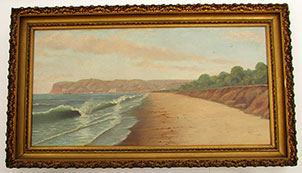
|
detail |
back |
signature |

|
1.73 EARLY 18th CENTURY ETCHING. Original, beautifully hand-colored etching by Francois Halma, dating circa 1706. It features a golden medallion depicting the Emperor Constantine flanked by two admiring puti. On either side are a woman in Roman dress and a helmeted warier with plumage and a spear. They are on either side of a grand battle scene entitled “IN HOC SIGNOVINCES.” Below are some thick bound volumes and a cartouche of a morbid figure. This images no doubt have some symbolic significance. At the lower left is the faint image appearing to be a conjoined “ID.” This etching is on early rag paper and bears the telltale plate mark on its edges. It measures 3 ½ x 5 inches sight. On the back is the certificate of authentication by ANTIUQUARIA SANT ANGELO of Rome, Italy. Condition is excellent. The colors are vibrant and the paper is perfect. Mounted is a simple acid free black mat measuring 7 ½ by 7 ½ inches. An amazing image over 300 years old! 99 |
detail |
authentication |
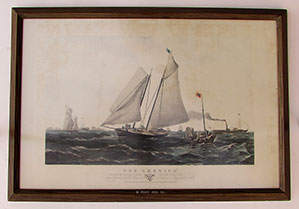
|
detail |
title |
title detail |

|
1.24 FAMOUS YACHT PAINTING. John Hughes, British-American, (1806-1878) (attrib.) oil on artist's board of the most famous racing yacht of them all, the Yacht AMERICA. This dramatic rendering depicts the schooner AMERICA under full sail slicing through waves with spray in a stiff breeze on a port tack. She flies the American ensign from the spanker and at least seven crewmen are visible on deck. The painter has captured the instant in time with realistic detail down to the mast hoops, reefing lines and decorated billet. The scene is an open ocean yacht race with 3 other yachts on similar tacks and a 3-masted bark in the far distance. Painted at the peak of Hughes' career, this painting very possibly it is THE Royal Yacht Squadron's Regatta in which AMERICA won the America's Cup in 1851. It measures 17 1/2 by 11 1/2 inches and is housed in a magnificent period antique gilt gesso frame measuring 27 1/4 by 21 inches. Outstanding condition in all respects. SOLD To those familiar with yachting history the AMERICA needs no introduction. AMERICA's genesis was sparked by an invitation from the Royal Yacht Squadron in England for an American vessel to participate in the Great Exhibition. Under Prince Albert's guidance, the exhibition was to be the first World's Fair up to that time. New York Yacht Club Commodore John C. Stevens took up the call and set about to build the "fastest yacht afloat." Stevens gathered a syndicate including Edwin Schuyler, J. Beekman Findlay and Hamilton Wilkes. They commissioned yacht designer George Steers, then working at the yard of William Brown on the East River in New York. What they created was a yacht with clipper bow, sharp forebody and a broad beam of 23 feet well aft. With a registered length of 93 1/2 feet and an 81 foot main mast, the yacht displaced 170 tons. Launched on May 3, 1851, to the most critical American eye she had particular grace. However when the tradition-steeped British builders first saw her they were horrified! AMERICA arrived in British waters in July, however no races had been planned and no serious British challenges offered. Almost as an afterthought AMERICA's skipper, Richard Brown, suggested that his yacht be entered in the Royal Yacht Squadron's regatta race around the Isle of Wight for an "ordinary cup" worth one hundred guineas. The day of the race, Queen Victoria herself, aboard her yacht VICTORIA AND ALBERT was on hand to view the spectacle. 18 yachts were entered into the race. On board AMERICA, were 21 men including a local pilot. At the start of the race AMERICA was last to get underway, but as the yachts reached The Needles for the run home a signalman on the Royal Yacht reported sighting the AMERICA. "Oh, indeed! And which is second?" was the Queen's query. As the signalman again swept the horizon with his spyglass, with a quivering voice he announced, "I regret to inform Her Majesty there is no second." As it turns out of course, there was a second, the gallant little yacht AURORA. But she was so far behind that the actual time of her crossing the finish remains unclear. The London Illustrated News reported a lapse of 21 minutes. Some 20 years after the race the New York Yacht Club accepted 8 minutes as the official figure. It was a Yankee victory and a notable one which was to profoundly shake British yachting circles for decades to come. The "Aulde Cup" as it came to be known and later, popularly, the "America's Cup," found a home in the New York Yacht Club for the next 132 years! |
DETAIL |

|
DETAIL |
SHIP |
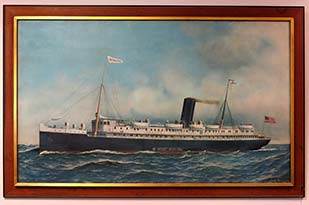
|
1.14 PAINTING. Important, large and impressive marine painting by the famed ship artist Antonio Nicolo Gasparo Jacobsen (Danish-American, 1850-1921). This spectacular oil on canvas painting depicts the graceful steam/auxilliary sail passenger ship APACHE underway at sea. In a portside ship's portrait Jacobsen has captured the essence of this well known vessel in a fresh breeze with sails furled and name pennant, house flag and American ensign flying. As the ship plies choppy deep green seas, puffy cumulus clouds punctuate the azure sky while wisps of smoke and steam spill from the large solitary smoke stack. This especially pleasing rendering is boldly signed lower right "Antonio Jacobsen/Palisade Av. Division St./West Hoboken, NJ" and dates to 1904. It is housed in a simple wooden frame with gold liner measuring 35 by 55 inches. The painting itself measures 30 by 50 inches sight and is on its original wooden stretcher. It has just been professionally cleaned and relined. There is very little inpainting in evidence under ultraviolet light. What little there is consists of a few small areas in the sky only. There is no retouching to the vessel itself. Excellent, ready to display condition. Price Request The much heralded steam/sail passenger ship APACHE was launched by William Cramp & Son Shipbuilders, Philadelphia, PA in 1901. She was successfully operated by the Clyde Steamship Company out of her home port of New York during a profitable career which spanned 27 years. Literature: Harold Sniffen, "ANTONIO JACOBSEN The Chesklist," 1984, The Mariner's Museum, Newport News, VA, pages 32-33, item number 31. Dated 1904.
|
DETAIL |
APACHE |
SIGNATURE |
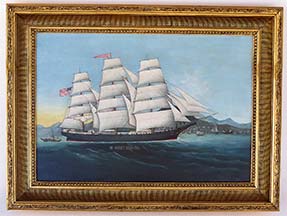
|
1.68 PAINTING. Genuine, highly sought after, mid-19th century oil on canvas port painting of the American clippership R. B. FULLER making its approaches to Hong Kong. This classic China Trade ship’s portrait shows a starboard broadside view of the true clipper under full sail with only the mizzen furled as she sails into port. A number of crewmen are depicted on deck ready to take in sail on the captain’s orders. The ship prominently flies the name pennant “R. B. FULLER” from the main mast and the American ensign from the spanker boom aft. Deck details are clearly visible as are the gold trailboard along the bow and the ship’s nameboard. In the background loom the famous hills of Hong Kong Harbor lined with quaint buildings, while the harbor is full of busy sailing vessels including the old hulk of a prison ship. Just astern of the FULLER is a nicely rendered Chinese junk. This predominantly deep blue painting is accentuated by the contrasty white sails of the clippership, making for a most dramatic presentation. The pristine canvas is NOT relined and is mounted on its original old wooden stretcher. It measures 17 ½ by 21 ½ inches sight and is housed in its very handsome antique gilt gessoed frame measuring 24 by 32 inches. The painting is in remarkably untouched original condition. Ready to hang. Guaranteed to be of the period and at least 150 years old! Museum quality. Price Request |
painting |
detail |
ship |
back |
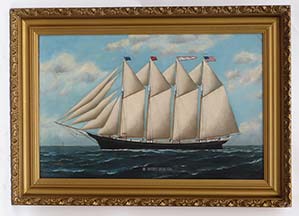
|
1.66 SHIP’s PORTRAIT. Solon Francis Montecello Badger, American, 19th century, oil on canvas paining of the American 4-masted schooner “ESTELLE PHINNEY” as prominently noted on the quarterboard, name pennant and stern quarter board. It is signed, lower left, “S.F.M. Badger 98.” This comprehensive work depicts the lovely vessel under full sail at sea with the coast and a prominent lighthouse in the background. Nine men are shown at various work stations on deck. Execution is extremely fine, including the foc'sle capstan, foredeck house with Charlie Nobel, 2 mid-deck hatches, midships deck house, after cargo hatch, aft deck house with skylights, helm, steering gear box and the ship’s lifeboat suspended on davits over the stern. She flies the Union Jack from the foremast, the ship’s flag “EP” from the mizzen, the ship’s name pennant from the main and the American ensign from the aftermast. On the poop deck the Captain can be seen pointing forward with helmsman at the wheel. It is obvious from the minute details depicted in this work the artist painted “from life” rather than from sketches or a photograph. Much more detail than the typical Jacobsen! The painting is clean and bright. The colors are rich and all lines are crisp including scores of subtle reefing lines on the sails. It measures 24 by 40 inches sight and is housed in a magnificent period gilted gesso wooden frame 34 ½ by 48 ½ inches. Solon Francis Montecello Badger was born in Boston in 1873 and grew up in neighboring Charleston, Massachusetts. As a teenager he lodged with and was apprenticed to the well known Maine ship portrait painter William P. Stubbs. In his early 20’s Badger took up ship painting, sailing around Boston Harbor in a small craft seeking commissions for his art from ship owners in that busy port. As a result, his works reflect meticulous attention to detail required of him to “get it right” for his demanding sea borne clientele. To these ends, sometimes he even worked from blueprints! Badger died at the relatively young age of 46. As his artwork gained notoriety after his death, he was known by the misnomer "Samuel Finley Morse Badger." The unknown reason for this name discrepancy was only corrected a few years ago. Museums exhibiting his work include the Maine Maritime Museum, Peabody Essex Museum, Mystic Seaport Museum and the Mariners’ Museum. |
detail |
back detail |
ship |
signature |
back |
1.40 IMPORTANT MINIATURE PORTRAIT. Genuine 18th century Continental oil on ivory portrait miniature of a stately nobleman identified on the reverse in beautiful hand-written script as the "Barone Massimiliouro De Flercles." This handsome young gentleman with lace collar is dressed in typical 18th C. finery. Probably of Belgium origin. An extremely well done miniature which bears close scrutiny under the most powerful magnification! Housed in its original gilt metal frame 2 by 2 1/4 inches. Superb, untouched original condition. 695
Preceding the advent of the Daguerreotype, the first form of photography introduced in 1839, portrait miniatures such as this example, were the only means by which wealthy patrons could insure that their likenesses were preserved for posterity. |

|
1.34 PAINTING. William Pierce Stubbs, American, 19th century, oil on canvas, ship’s portrait of the 3-masted schooner MORRIS W. CHILD. This original large format rendering depicts the vessel in a port side view at sea under full sail. An island with lighthouse is shown on the left, while a steamer is visible on the horizon to the right. The handsome schooner flies the Union Jack from the foremast, the owner’s flag from the main, a colorful swallow tail name pennant from the mizzen and the American ensign from the spanker aft. The artist has lavished particular care in portraying the complex rigging as well as deck details, including crewman about their chores amidships and on the poop. This painting measures 22 by 36 inches sight and is housed in its original ornate gilt gesso frame measuring 32 ¼ by 46 ¼ inches. It is signed lower left, “W. P. Stubbs.” Condition is excellent. The painting has been professionally cleaned and relined, retaining all of its original color, brightness and detail. The ornate frame with floral designs has been fully restored. According to a label on the reverse this work was performed by Fynmore Studios, Boonville, N.Y. in April 1973. Examination under black light shows modest inpainting, primarily in the sky and on the periphery due to stretcher bar wear, as expected of oil on canvas paintings over 100 years old. SOLD The 3-masted schooner MORRIS W. CHILD, official number 91311, call sign J.V.F.L., was built in Bath, Maine by H. M. Bean in 1881. She had a length of 145 feet, a breadth of 34 feet, a draft of 12 ½ feet and displaced 513 gross tons. As of 1885 her master was Captain Torrey and her owners were J.P. Ellicot and Company, homeported in Boston, Massachusetts. (“The Record of American & Foreign Shipping,” 1885, American Shipmasters’ Association). |
SHIP |
BACK |


